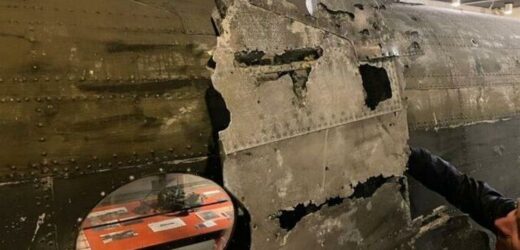London: World War Two underground Blitz shelter explored
We use your sign-up to provide content in ways you’ve consented to and to improve our understanding of you. This may include adverts from us and 3rd parties based on our understanding. You can unsubscribe at any time. More info
The piece of the wrecked WW2 ‘Short Stirling’ four-engined heavy bomber was discovered by locals on the beach at Camperduin, a small village in the province of North Holland. Analysis of serial numbers on the twisted hunk of metal have indicated that the craft is most likely the bomber BF396, which never returned to RAF Newmarket following a raid on industrial facilities in the Fallersleben district of Wolfsburg, Germany, on the night of December 17, 1942. Shot down by a Nazi fighter plane, the BF396 was lost along with its crew, which included – pilot Victor Mitchell, second pilot Trevor Horace Bagnall, navigator Reginald William Pearson and air bomber Gerald Thomas Padden. Also lost was wireless operator Stuart John Goff, flight engineer Robert Hart, mid-upper gunner Arthur Henry Rider and rear gunner Albert Charles William Parker.
Martijn Visser — chair of Stichting Egmond ’40-’45, a World War 2 museum located near Camperduin — couldn’t believe his eyes when he saw the wreckage.
He said “I was astonished. We first looked at the details, there were stamps on it which said ‘AM.’ ”
This would have been short for the “Air Ministry”, the Government department responsible for managing the affairs of the Royal Air Force from 1918–1964.
Mr Visser added: “After that, we looked at old pictures of World War 2 planes to find the details we saw on the wreckage.
“We also discovered some numbers on the inside of the fuselage. These numbers are unique for Short Stirling planes.
“Then we took the wreckage parts to a museum here in the Netherlands which has an original Short Stirling fuselage from World War 2.
“We compared the pieces and they matched!”


The fateful last flight of the BF396 was Sergeant Gerald Thomas Padden’s first mission — he was just 20 years of age.
He is survived by his younger brother, Dennis Padden, whose son Graham has been researching the life of his uncle.
Graham Padden said: “I was somewhat taken aback when I was contacted with the news that the wreckage had washed up.
“Whilst we are not certain that it is wreckage from BF396, there is a very high degree of certainty.”


Graham Padden added: “My father, now approaching 92, is still alive and is following developments keenly.
“He can remember ‘Bunty’ — that was his brother’s nickname — but he was killed when my father was a 12-year-old boy.
“I think the next steps might be to try and locate the wrecked aircraft, and of course the eight souls that perished in the cold sea as the burning aircraft met its end on a dark December night.
“Recovery, firm identification or personal effects would certainly bring some closure to my father.”
DON’T MISS:
Solar ‘tsunami’ sparks radio blackout before storm makes direct hit [ANALYSIS]
Lift-off! Jeff Bezos’ Blue Origin fires five tourists into space [REPORT]
Russia issues threat as NASA astronaut to leave ISS: ‘We can fight’ [INSIGHT]

The pilot of the twin-engine Messerschmitt which shot down the BF396 over the Dutch coast was the Luftwaffe night fighter ace Oberleutnant (and later Major) Werner Husemann.
He claimed 34 aerial combat victories during World War 2, and was awarded the Nazi military’s highest award — the Knight’s Cross of the Iron Cross — on September 30, 1944.
Major Husemann passed away on February 2, 2014, at the age of 94.
The piece of wreckage from the BF396 is to be kept in the collections of the Stichting Egmond ’40-’45 bunker museum.
Additional reporting by Michael Havis.
Source: Read Full Article


